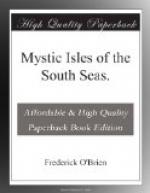Always, in the approach to the island in steamship, schooner, or canoe, one is amazed and transported by the varying aspect of it. A few miles away one would never know that man had touched it. His inappreciable structures are erased by the flood of green color, which, from the edge of the lagoon to the spires of La Diademe, nearly eight thousand feet above the water, makes all other hues insignificant. In all its hundred miles or so of circumference nature is the dominant note—a nature so mysterious, so powerful, and yet so soft-handed, so beauty-loving and so laughing in its indulgences, that one can hardly believe it the same that rules the Northern climes and forces man to labor in pain all his days or to die.
The scene from a little distance is as primeval as when the first humans climbed in their frail canoes through the unknown and terrible stretches of ocean, and saw Tahiti shining in the sunlight. A mile or two from the lagoon the fertile land extends as a slowly-ascending gamut of greens as luxuriant as a jungle, and forming a most pleasing foreground to the startling amphitheater of the mountains, darker, and, in storm, black and forbidding.
Those mountains are the most wonderful examples of volcanic rock on the globe. Formed of rough and crystalline products of the basic fire of earth, they hold high up in their recesses coral beds once under the sea, and lava in many shapes, tokens of the island’s rise from the slime, and of mammoth craters now almost entirely obliterated by denudation—the denudation which made the level land as fertile as any on earth, and the suitable habitation of the most leisurely and magnificent human animals of history.
A thousand rills that drink from the clouds ever encircling the crags, and in which they are often lost from view, leap from the heights, appearing as ribbons of white on a clear day, and not seldom disappearing in vapor as they fall sheer hundreds of feet, or thousands, in successive drops. When heavy rains come, torrents suddenly spring into being and dash madly down the precipitous cliffs to swell the brooks and little rivers and rush headlong to the sea.
Tahiti has an unexcelled climate for the tropics, the temperature for the year averaging seventy-seven degrees and varying from sixty-nine to eighty-four degrees. June, July, and August are the coolest and driest months, and December to March the rainiest and hottest. It is often humid, enervating, but the south-east, the trade-wind, which blows regularly on the east side of the islands, where are Papeete and most of the settlements, purifies the atmosphere, and there are no epidemics except when disease is brought directly from the cities of America or Australasia. A delicious breeze comes up every morning at nine o’clock and fans the dweller in this real Arcadia until past four, when it languishes and ceases in preparation for the vesper drama of the sun’s retirement from the stage of earth.




